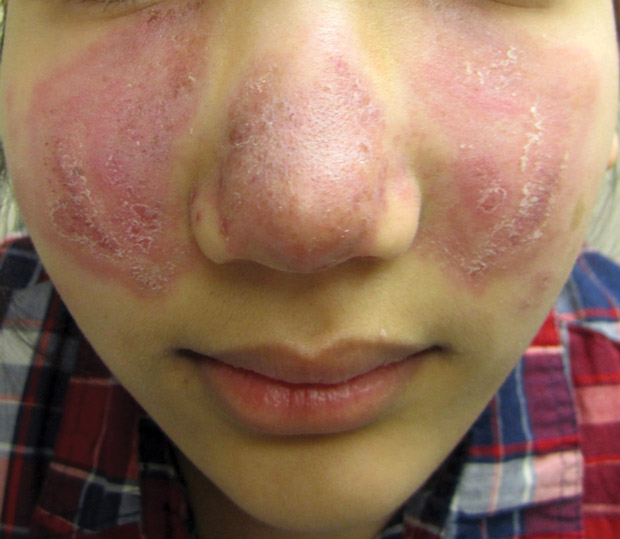MKSAP Quiz: 1-month history of progressive rash
A 22-year-old woman is evaluated for a 1-month history of progressive rash on the face, chest, and arms following sun exposure. She also has experienced wrist arthralgia and malaise for the past 2 weeks.

On physical examination, blood pressure is 142/82 mm Hg, pulse rate is 88/min, and respiration rate is 16/min. The facial rash is shown.
Similar-appearing patchy skin lesions are seen over the upper chest in a V-neck distribution and the dorsal forearms. Active and passive wrist extension elicits discomfort. The remainder of the examination is normal.
Which of the following is the most likely diagnosis?
A. Acute cutaneous lupus erythematosus
B. Lupus pernio
C. Rosacea
D. Subacute cutaneous lupus erythematosus
Answer and critique
The correct answer is A. Acute cutaneous lupus erythematosus. This item is Question 31 in MKSAP 19's Rheumatology section.
The most likely diagnosis is acute cutaneous lupus erythematosus (ACLE) (Option A). Cutaneous lupus erythematosus can exist with or without systemic disease. There are three primary patterns of lupus-specific skin rashes: ACLE, subacute cutaneous lupus erythematosus, and chronic cutaneous lupus erythematosus. The lupus-specific skin diseases are not found in other conditions and have varying associations with systemic lupus erythematosus (SLE). Identifying the pattern of the skin disease can be important for guiding additional evaluation and treatment. ACLE often presents with a photosensitive malar or butterfly rash, with patchy, edematous, erythematous areas on the cheeks and over the nose, sparing the nasolabial folds. Similar rashes can occur on other sun-exposed skin, including the neck, upper chest, and arms. Nearly all patients with ACLE have SLE, and as such tend to have systemic symptoms and positive serologic results (typically antinuclear, anti-Ro/SSA, and anti-La/SSB antibodies).
Lupus pernio (Option B) is a skin manifestation seen in some patients with sarcoidosis. Skin lesions can occur on the face, including the cheeks, nose, lips, forehead, or ears, and are firm and purple. These skin lesions are not photosensitive and do not appear on the chest or arms.
Rosacea (Option C) is the most common cause of an erythematous rash in the malar distribution. Rosacea is more likely to include pustular lesions and visible telangiectasias and does not spare the nasolabial fold.
Subacute cutaneous lupus erythematosus (SCLE) (Option D) appears as one of two variants: annular and polycyclic photosensitive plaques on the back, chest, and extremities, or psoriasiform scaly plaques in a similar distribution. SCLE does not scar but may resolve with temporary pigmentary changes. Fewer than one in four patients with SCLE have SLE, and as many as one in three cases are drug induced. The latter may resolve with withdrawal of the causative agent. This patient's rash does not match the typical presentation of SCLE.
Key Points
- Acute cutaneous lupus erythematosus often presents with the classic photosensitive malar or butterfly rash, with patchy, edematous, erythematous areas on the cheeks and over the nose, sparing the nasolabial folds; similar rashes can occur on other sun-exposed skin, including the neck, upper chest, and arms.
- Nearly all patients with acute cutaneous lupus erythematosus have systemic lupus erythematosus and as such tend to have systemic symptoms and positive serologies.




